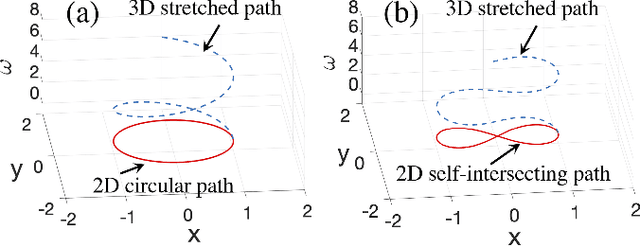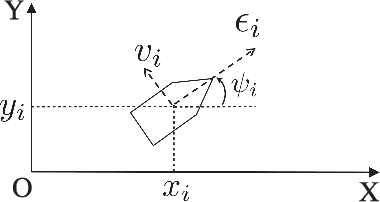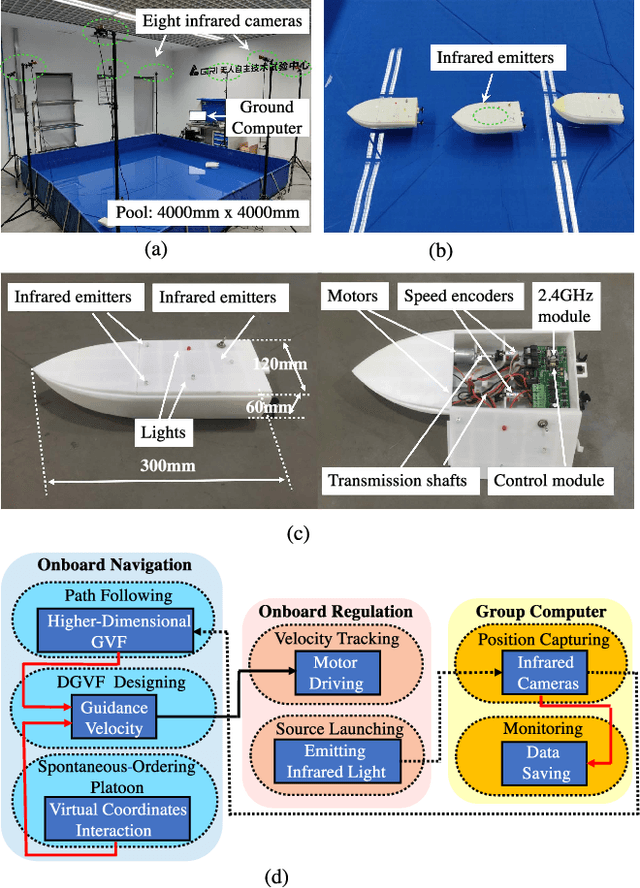Ming Cao
Equilibrium-Driven Smooth Separation and Navigation of Marsupial Robotic Systems
Jun 16, 2025Abstract:In this paper, we propose an equilibrium-driven controller that enables a marsupial carrier-passenger robotic system to achieve smooth carrier-passenger separation and then to navigate the passenger robot toward a predetermined target point. Particularly, we design a potential gradient in the form of a cubic polynomial for the passenger's controller as a function of the carrier-passenger and carrier-target distances in the moving carrier's frame. This introduces multiple equilibrium points corresponding to the zero state of the error dynamic system during carrier-passenger separation. The change of equilibrium points is associated with the change in their attraction regions, enabling smooth carrier-passenger separation and afterwards seamless navigation toward the target. Finally, simulations demonstrate the effectiveness and adaptability of the proposed controller in environments containing obstacles.
High-order Regularization for Machine Learning and Learning-based Control
May 13, 2025Abstract:The paper proposes a novel regularization procedure for machine learning. The proposed high-order regularization (HR) provides new insight into regularization, which is widely used to train a neural network that can be utilized to approximate the action-value function in general reinforcement learning problems. The proposed HR method ensures the provable convergence of the approximation algorithm, which makes the much-needed connection between regularization and explainable learning using neural networks. The proposed HR method theoretically demonstrates that regularization can be regarded as an approximation in terms of inverse mapping with explicitly calculable approximation error, and the $L_2$ regularization is a lower-order case of the proposed method. We provide lower and upper bounds for the error of the proposed HR solution, which helps build a reliable model. We also find that regularization with the proposed HR can be regarded as a contraction. We prove that the generalizability of neural networks can be maximized with a proper regularization matrix, and the proposed HR is applicable for neural networks with any mapping matrix. With the theoretical explanation of the extreme learning machine for neural network training and the proposed high-order regularization, one can better interpret the output of the neural network, thus leading to explainable learning. We present a case study based on regularized extreme learning neural networks to demonstrate the application of the proposed HR and give the corresponding incremental HR solution. We verify the performance of the proposed HR method by solving a classic control problem in reinforcement learning. The result demonstrates the superior performance of the method with significant enhancement in the generalizability of the neural network.
GenSwarm: Scalable Multi-Robot Code-Policy Generation and Deployment via Language Models
Mar 31, 2025Abstract:The development of control policies for multi-robot systems traditionally follows a complex and labor-intensive process, often lacking the flexibility to adapt to dynamic tasks. This has motivated research on methods to automatically create control policies. However, these methods require iterative processes of manually crafting and refining objective functions, thereby prolonging the development cycle. This work introduces \textit{GenSwarm}, an end-to-end system that leverages large language models to automatically generate and deploy control policies for multi-robot tasks based on simple user instructions in natural language. As a multi-language-agent system, GenSwarm achieves zero-shot learning, enabling rapid adaptation to altered or unseen tasks. The white-box nature of the code policies ensures strong reproducibility and interpretability. With its scalable software and hardware architectures, GenSwarm supports efficient policy deployment on both simulated and real-world multi-robot systems, realizing an instruction-to-execution end-to-end functionality that could prove valuable for robotics specialists and non-specialists alike.The code of the proposed GenSwarm system is available online: https://github.com/WindyLab/GenSwarm.
Robust simultaneous UWB-anchor calibration and robot localization for emergency situations
Mar 28, 2025Abstract:In this work, we propose a factor graph optimization (FGO) framework to simultaneously solve the calibration problem for Ultra-WideBand (UWB) anchors and the robot localization problem. Calibrating UWB anchors manually can be time-consuming and even impossible in emergencies or those situations without special calibration tools. Therefore, automatic estimation of the anchor positions becomes a necessity. The proposed method enables the creation of a soft sensor providing the position information of the anchors in a UWB network. This soft sensor requires only UWB and LiDAR measurements measured from a moving robot. The proposed FGO framework is suitable for the calibration of an extendable large UWB network. Moreover, the anchor calibration problem and robot localization problem can be solved simultaneously, which saves time for UWB network deployment. The proposed framework also helps to avoid artificial errors in the UWB-anchor position estimation and improves the accuracy and robustness of the robot-pose. The experimental results of the robot localization using LiDAR and a UWB network in a 3D environment are discussed, demonstrating the performance of the proposed method. More specifically, the anchor calibration problem with four anchors and the robot localization problem can be solved simultaneously and automatically within 30 seconds by the proposed framework. The supplementary video and codes can be accessed via https://github.com/LiuxhRobotAI/Simultaneous_calibration_localization.
VLN-Game: Vision-Language Equilibrium Search for Zero-Shot Semantic Navigation
Nov 18, 2024Abstract:Following human instructions to explore and search for a specified target in an unfamiliar environment is a crucial skill for mobile service robots. Most of the previous works on object goal navigation have typically focused on a single input modality as the target, which may lead to limited consideration of language descriptions containing detailed attributes and spatial relationships. To address this limitation, we propose VLN-Game, a novel zero-shot framework for visual target navigation that can process object names and descriptive language targets effectively. To be more precise, our approach constructs a 3D object-centric spatial map by integrating pre-trained visual-language features with a 3D reconstruction of the physical environment. Then, the framework identifies the most promising areas to explore in search of potential target candidates. A game-theoretic vision language model is employed to determine which target best matches the given language description. Experiments conducted on the Habitat-Matterport 3D (HM3D) dataset demonstrate that the proposed framework achieves state-of-the-art performance in both object goal navigation and language-based navigation tasks. Moreover, we show that VLN-Game can be easily deployed on real-world robots. The success of VLN-Game highlights the promising potential of using game-theoretic methods with compact vision-language models to advance decision-making capabilities in robotic systems. The supplementary video and code can be accessed via the following link: https://sites.google.com/view/vln-game.
PANav: Toward Privacy-Aware Robot Navigation via Vision-Language Models
Oct 05, 2024



Abstract:Navigating robots discreetly in human work environments while considering the possible privacy implications of robotic tasks presents significant challenges. Such scenarios are increasingly common, for instance, when robots transport sensitive objects that demand high levels of privacy in spaces crowded with human activities. While extensive research has been conducted on robotic path planning and social awareness, current robotic systems still lack the functionality of privacy-aware navigation in public environments. To address this, we propose a new framework for mobile robot navigation that leverages vision-language models to incorporate privacy awareness into adaptive path planning. Specifically, all potential paths from the starting point to the destination are generated using the A* algorithm. Concurrently, the vision-language model is used to infer the optimal path for privacy-awareness, given the environmental layout and the navigational instruction. This approach aims to minimize the robot's exposure to human activities and preserve the privacy of the robot and its surroundings. Experimental results on the S3DIS dataset demonstrate that our framework significantly enhances mobile robots' privacy awareness of navigation in human-shared public environments. Furthermore, we demonstrate the practical applicability of our framework by successfully navigating a robotic platform through real-world office environments. The supplementary video and code can be accessed via the following link: https://sites.google.com/view/privacy-aware-nav.
High-order regularization dealing with ill-conditioned robot localization problems
Oct 02, 2024Abstract:In this work, we propose a high-order regularization method to solve the ill-conditioned problems in robot localization. Numerical solutions to robot localization problems are often unstable when the problems are ill-conditioned. A typical way to solve ill-conditioned problems is regularization, and a classical regularization method is the Tikhonov regularization. It is shown that the Tikhonov regularization can be seen as a low-order case of our method. We find that the proposed method is superior to the Tikhonov regularization in approximating some ill-conditioned inverse problems, such as robot localization problems. The proposed method overcomes the over-smoothing problem in the Tikhonov regularization as it can use more than one term in the approximation of the matrix inverse, and an explanation for the over-smoothing of the Tikhonov regularization is given. Moreover, one a priori criterion which improves the numerical stability of the ill-conditioned problem is proposed to obtain an optimal regularization matrix. As most of the regularization solutions are biased, we also provide two bias-correction techniques for the proposed high-order regularization. The simulation and experiment results using a sensor network in a 3D environment are discussed, demonstrating the performance of the proposed method.
Coordinated Guiding Vector Field Design for Ordering-Flexible Multi-Robot Surface Navigation
Jan 25, 2024



Abstract:We design a distributed coordinated guiding vector field (CGVF) for a group of robots to achieve ordering-flexible motion coordination while maneuvering on a desired two-dimensional (2D) surface. The CGVF is characterized by three terms, i.e., a convergence term to drive the robots to converge to the desired surface, a propagation term to provide a traversing direction for maneuvering on the desired surface, and a coordinated term to achieve the surface motion coordination with an arbitrary ordering of the robotic group. By setting the surface parameters as additional virtual coordinates, the proposed approach eliminates the potential singularity of the CGVF and enables both the global convergence to the desired surface and the maneuvering on the surface from all possible initial conditions. The ordering-flexible surface motion coordination is realized by each robot to share with its neighbors only two virtual coordinates, i.e. that of a given target and that of its own, which reduces the communication and computation cost in multi-robot surface navigation. Finally, the effectiveness of the CGVF is substantiated by extensive numerical simulations.
Spontaneous-Ordering Platoon Control for Multirobot Path Navigation Using Guiding Vector Fields
Nov 02, 2023



Abstract:In this paper, we propose a distributed guiding-vector-field (DGVF) algorithm for a team of robots to form a spontaneous-ordering platoon moving along a predefined desired path in the n-dimensional Euclidean space. Particularly, by adding a path parameter as an additional virtual coordinate to each robot, the DGVF algorithm can eliminate the singular points where the vector fields vanish, and govern robots to approach a closed and even self-intersecting desired path. Then, the interactions among neighboring robots and a virtual target robot through their virtual coordinates enable the realization of the desired platoon; in particular, relative parametric displacements can be achieved with arbitrary ordering sequences. Rigorous analysis is provided to guarantee the global convergence to the spontaneous-ordering platoon on the common desired path from any initial positions. 2D experiments using three HUSTER-0.3 unmanned surface vessels (USVs) are conducted to validate the practical effectiveness of the proposed DGVF algorithm, and 3D numerical simulations are presented to demonstrate its effectiveness and robustness when tackling higher-dimensional multi-robot path-navigation missions and some robots breakdown.
Co-NavGPT: Multi-Robot Cooperative Visual Semantic Navigation using Large Language Models
Oct 11, 2023



Abstract:In advanced human-robot interaction tasks, visual target navigation is crucial for autonomous robots navigating unknown environments. While numerous approaches have been developed in the past, most are designed for single-robot operations, which often suffer from reduced efficiency and robustness due to environmental complexities. Furthermore, learning policies for multi-robot collaboration are resource-intensive. To address these challenges, we propose Co-NavGPT, an innovative framework that integrates Large Language Models (LLMs) as a global planner for multi-robot cooperative visual target navigation. Co-NavGPT encodes the explored environment data into prompts, enhancing LLMs' scene comprehension. It then assigns exploration frontiers to each robot for efficient target search. Experimental results on Habitat-Matterport 3D (HM3D) demonstrate that Co-NavGPT surpasses existing models in success rates and efficiency without any learning process, demonstrating the vast potential of LLMs in multi-robot collaboration domains. The supplementary video, prompts, and code can be accessed via the following link: \href{https://sites.google.com/view/co-navgpt}{https://sites.google.com/view/co-navgpt}.
 Add to Chrome
Add to Chrome Add to Firefox
Add to Firefox Add to Edge
Add to Edge